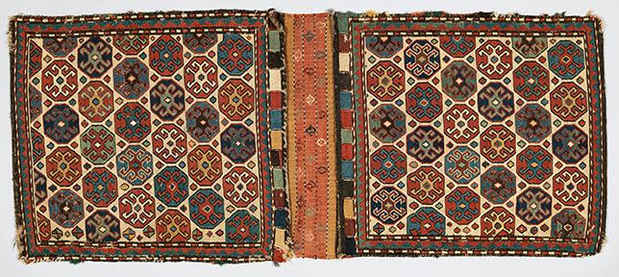“Nomadic Weavings from the Collection of William and Inger Ginsberg” Exhibition
The Metropolitan Museum of Art

This event has ended.
The Met Fifth Avenue, The Hagop Kevorkian Fund Special Exhibitions Gallery
Floor 2, Gallery 458
Woven bags produced by and for nomads from Iran, Turkey, and the Caucasus contained all of the necessities of life, from bedding to salt. Opening September 25 at The Metropolitan Museum of Art, the exhibition Portable Storage: Tribal Weavings from the Collection of William and Inger Ginsberg will highlight 19 distinctly patterned examples of woven bags, accompanied by one pile-woven saddle cover, that lend insight into a way of life practiced in the Middle East for hundreds of years. The gift, which came to The Met in 2015, greatly expands the Museum’s holdings of tribal weavings from the region. The exhibition will also include two Islamic paintings from the Museum’s collection that illustrate bags and trappings in use in traditional society.
The exhibition is made possible by The Hagop Kevorkian Fund.
The Ginsbergs have been interested in small textiles since the 1970s, and became more active as collectors in the 1990s. Their collection focuses primarily on tribes living in Iran and the surrounding areas.
The exhibition will include bags specifically designed to hold flour, salt, and bedding. Also on view will be more than a dozen examples of the ubiquitous khorjin or double bag used throughout the Middle East as a kind of briefcase-handbag, woven by women from the Shahsevan, Bakhtiari, Khamseh, Qashqa’i, and other tribes that populated 19th-century Iran, Turkey, and Transcaucasia. Each tribe had its own preferred weaving styles and techniques, by which the bags can often be identified. Woven in intense hues of red, blue, and yellow achieved using traditional dyeing methods and natural materials, along with undyed white wool, these textiles–— at once utilitarian and expressive of a sophisticated tribal esthetic–— are decorated primarily with geometric patterns. Stylized floral and animal motifs are also used. A variety of techniques–— often several in combination in a single bag–— were employed: slit-tapestry weave (kilim), brocading, warp-wrapping (sumak), and knotted pile. The latter technique was often used structurally, to strengthen the bottom of the bags and to protect them from abrasion. While for most of the pieces the weavers used wool and cotton, one larger saddle bag was embellished as well with metal-wrapped yarns.
Prominently displayed within the exhibition will be a large bedding bag from the Shahsevan tribe, which is based along the border between present-day Iran and the Republic of Azerbaijan. In construction and decoration, it displays the marriage of aesthetics and utility that is characteristic of these objects. Included within the otherwise geometric ornament of one pile-woven saddlebag is the unexpected image of an elephant, demonstrating the creative latitude and playfulness often exhibited by the women who wove these traditional items.
Media
Schedule
from September 25, 2017 to May 07, 2018